Book contents
- Frontmatter
- Contents
- Dedication
- Acknowledgements
- Abbreviations
- 1 INTRODUCTION
- 2 FAMILY AND EARLY LIFE
- 3 THE BISHOPRIC OF EXETER
- 4 ROYAL FREE CHAPELS
- 5 THE FOUNDATION OF STAPELDON HALL
- 6 POLITICS AND DIPLOMACY 1309–13
- 7 THE CONSOLIDATION AND COLLAPSE OF ROYAL POWER 1320–1326
- 8 THE EXCHEQUER
- 9 THE CASE AGAINST STAPELDON
- 10 MURDER
- Appendix of documents
- Bibliography
- Index
7 - THE CONSOLIDATION AND COLLAPSE OF ROYAL POWER 1320–1326
Published online by Cambridge University Press: 05 November 2011
- Frontmatter
- Contents
- Dedication
- Acknowledgements
- Abbreviations
- 1 INTRODUCTION
- 2 FAMILY AND EARLY LIFE
- 3 THE BISHOPRIC OF EXETER
- 4 ROYAL FREE CHAPELS
- 5 THE FOUNDATION OF STAPELDON HALL
- 6 POLITICS AND DIPLOMACY 1309–13
- 7 THE CONSOLIDATION AND COLLAPSE OF ROYAL POWER 1320–1326
- 8 THE EXCHEQUER
- 9 THE CASE AGAINST STAPELDON
- 10 MURDER
- Appendix of documents
- Bibliography
- Index
Summary
At the beginning of 1320 the three major offices of state changed hands. Their new occupants, none of whom had held office before, were all arguably appointed outside of parliament and therefore in contravention of the Ordinances. The promotion of Robert Baldock, who became keeper of the privy seal on 27 January, is almost certainly to be attributed to his association with the younger Despenser. Archdeacon of Middlesex and a canon of St Paul's, Baldock had been prominent in negotiations with the Scots since 1316. In July 1320 he also became controller of the Wardrobe. Three times the king tried and failed to obtain a bishopric for him.
John Salmon, bishop of Norwich, who succeeded the bishop of Ely as chancellor on 26 January, was an experienced diplomat who had played a leading rôle in the process of Périgueux. Although an Ordainer, he appears to have been the king's man. He took part in the mission to Clement V in 1309 which secured the revocation of Gaveston's exile and in 1316 he was the king's spokesman at the Lincoln parliament. A memorandum on the Close Roll records that the king nominated him in full parliament but makes no mention of baronial assent. The parliament concerned was that summoned to York for 20 January 1320 and chroniclers do describe the meeting that took place there as a parliament. The earl of Lancaster, however, refused to attend, commenting that it was not fitting to hold parliament ‘in cameris’.
- Type
- Chapter
- Information
- Politics, Finance and the Church in the Reign of Edward II , pp. 131 - 162Publisher: Cambridge University PressPrint publication year: 1983



